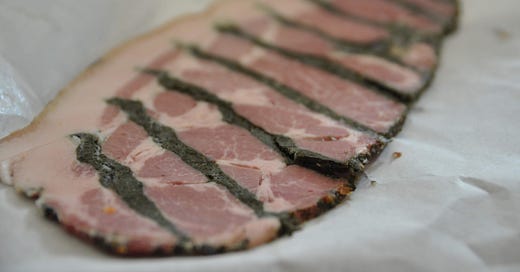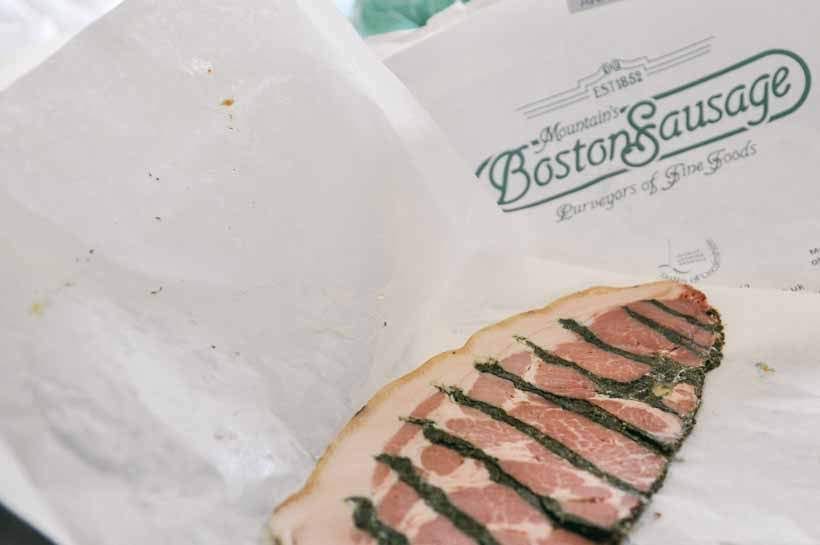From the Kitchen: Lincolnshire Stuffed Chine
A heritage food from the East Midlands of England, this salted pork dish is stuffed with parsley and poached - chronicled by Slow Food UK with the intent of preserving this regional delicacy.
Chine is an old English word for backbone, derived from Norman French. In general culinary use to indicate the backbone, with some attached flesh, of any animal until the 18th century, it continued to be used in connection with bacon pigs – from which the sides are normally removed without splitting the backbone.
It is not clear when the Lincolnshire version of stuffed chine developed, but it is a country in which pig rearing has always been important, and oral tradition indicates that the dish has a long history.
Stuffed chine was traditionally made from the now-extinct Lincolnshire Curly Coat pig, a breed that would grow very fat. Once hung to set up, the very thick layer of fat would firm up. This, combined with the difficulty of sawing directly through the backbone, supposedly led to the sawing through the ribs on either side, removing both flitches and leaving the chine running centrally from the nose to the tail.
The story goes that the chine, with rind only protecting the back and leaving a large area of exposed meat, went moldy while hanging. Having scrubbed off the mold, strong-tasting herbs were picked from the garden and packed into deep slits cut into the meat before it was boiled in a copper pot.
Lincolnshire Stuffed Chine is still in demand, in and out of the county; however, it is now maintained by only a small number of passionate producers. In much the same way as the Lincolnshire Curly Coat pig from which stuffed chine was made, if the remaining few skilled individuals who maintain the tradition stop production then the Lincolnshire Stuffed Chine will be lost.
Imitation stuffed chines are produced using bacon collars and sliced in the wrong direction to allow for the use of a slicing machine. These versions are not strictly traditional, but many of the processes are the same or similar, and they can play a role in preserving this regional delicacy.
From Slow Food UK
Unless you have a whole pig and some butchery skills, it is unlikely that you will be able to secure the cut of meat required to make this dish traditionally. As Slow Food UK notes, many recipes for this dish produced outside of Lincolnshire use bacon collars, although the dish will be quite different.
In 1984, Jane Grigson, a renowned food writer for the Observer for many years, printed a profile and recipe for chine in the aforementioned paper.
This superb Lincolnshire dish of salt pork filled with herbs is known as stuffed chine. Verlaine, in the mid-1870s, spent a year as a schoolmaster just north of Boston. He liked chine so much that he tried to find it elsewhere in England, but without success. Verlaine's chine was stuffed with leeks, spring onions, lettuce, raspberry leaves, parsley, thyme and marjoram. Nowadays parsley suffices.
Stuffed Chine, The Observer, March 1984, Jane Grigson
While Grigson’s recipe above describes the making of chine in great detail, if you aren’t within mail-order distance of Lincolnshire, have no fear - collar bacon is here. Cut from the shoulder of the pig, it is the same cut as a pork ribeye steak. The natural strips of fat that run through the muscle add moisture and flavor during the cooking process.
The recipe below is a little simpler to make at home anywhere in the world, and, unlike Grigson’s recipe, doesn’t require enough parsley to ‘fill a baby’s bath’!
Lincolnshire Stuffed Chine
YIELDS 7-8 Servings
PREP TIME 20 mins COOK TIME 1 hour 30 mins TOTAL TIME 1 hour 50 mins
3.5 lbs (1.6kg) collar bacon
3/4lb (340g) flat parsley
2 oz (50g) spring onions
2 oz (50g) blend of fresh thyme and marjoram
1 Put the collar bacon on a chopping board or tray, rind side down.
2 Rough chop all the herbs in a food processor - make sure not to blend too much, you still want discernible pieces. If you don’t have a blender, roughly chop by hand.
3 Make five or six deep cuts down into the meat, making sure not to cut right through the joint - these cuts should be about a 3/4 inch apart.
4 Stuff each of the cuts tightly with the herb mix, then tie with string to keep all the pockets together. Wrap tightly in a muslin cloth, and again with string.
5 Place the wrapped chine in a large pan and cover with fresh cold water.
6 Place the pan on the stove on maximum and bring it to a boil uncovered. Once the water is boiling, cover and continue to boil gently for 30 mins per pound (500g)
7 Take the chine out of the water and rest until cool. If you try and slice while still hot, it won’t have set properly! Slice thinly once it has cooled through, and serve with a dash of vinegar.






